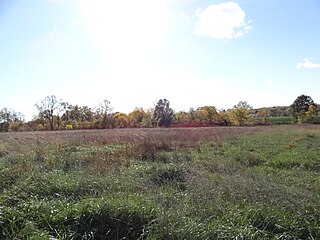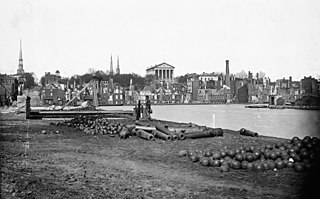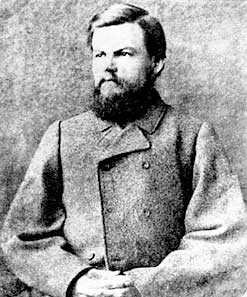
John Wilkes Booth was an American stage actor who assassinated United States President Abraham Lincoln at Ford's Theatre in Washington, D.C., on April 14, 1865. A member of the prominent 19th-century Booth theatrical family from Maryland, he was a noted actor who was also a Confederate sympathizer; denouncing President Lincoln, he lamented the then-recent abolition of slavery in the United States.

Nathan Bedford Forrest was a Confederate Army general during the American Civil War and was later the first Grand Wizard of the Ku Klux Klan from 1867 to 1869.

The Battle of the Crater took place during the American Civil War, part of the Siege of Petersburg. It occurred on Saturday, July 30, 1864, between the Confederate Army of Northern Virginia, commanded by General Robert E. Lee, and the Union Army of the Potomac, commanded by Major General George G. Meade.

The Battle of Marais des Cygnes took place on October 25, 1864, in Linn County, Kansas, during Price's Missouri Campaign during the American Civil War. It is also known as the Battle of Trading Post. In late 1864, Confederate Major-General Sterling Price invaded the state of Missouri with a cavalry force, attempting to draw Union troops away from the primary theaters of fighting further east. After several victories early in the campaign, Price's Confederate troops were defeated at the Battle of Westport on October 23 near Kansas City, Missouri. The Confederates then withdrew into Kansas, camping along the banks of the Marais des Cygnes River on the night of October 24. Union cavalry pursuers under Brigadier General John B. Sanborn skirmished with Price's rearguard that night, but disengaged without participating in heavy combat.

Jacob Thompson was the United States Secretary of the Interior, who resigned on the outbreak of the American Civil War and became the Inspector General of the Confederate States Army.
City Point was a town in Prince George County, Virginia, United States, that was annexed by the independent city of Hopewell in 1923. It served as headquarters of the Union Army during the siege of Petersburg during the American Civil War.
The Battle of Glasgow was fought on October 15, 1864, in and near Glasgow, Missouri, as part of Price's Missouri Expedition during the American Civil War. The battle resulted in the capture of needed weapons and improved Confederate morale, which had been dented after a defeat in the Battle of Pilot Knob.

Fort Lafayette was an island coastal fortification in the Narrows of New York Harbor, built offshore from Fort Hamilton at the southern tip of what is now Bay Ridge in the New York City borough of Brooklyn. The fort was built on a natural island known as Hendrick's Reef. Construction on the fort began during the War of 1812 and was completed in 1822. The fort, originally named Fort Diamond after its shape, was renamed in 1823 to celebrate the Marquis de La Fayette, a hero of the American Revolution who would soon commence a grand tour of the United States. During the American Civil War, the island fort became a prison, mostly for civilians viewed as disloyal to the Union; the fort became known as an "American Bastille." The fort was demolished in 1960 to make room for the Verrazzano-Narrows Bridge; the Brooklyn-side bridge tower now occupies the fort's former foundation site.
The Confederate Secret Service refers to any of a number of official and semi-official secret service organizations and operations conducted by the Confederate States of America during the American Civil War. Some of the organizations were under the direction of the Confederate government, others operated independently with government approval, while still others were either completely independent of the government or operated with only its tacit acknowledgment.

Edwin Henry Stoughton was appointed a brigadier general in the Union Army during the American Civil War, but his appointment expired after it was not confirmed by the U.S. Senate. Four days later, on March 8, 1863, he was captured by Confederate partisan ranger John S. Mosby while asleep at his headquarters in the Virginia village of Fairfax Court House. The incident became well known, and Stoughton became an object of ridicule as a result. He was included in a prisoner exchange two months later but resigned his commission after he was not reappointed as a brigadier general.

During the American Civil War (1861–1865), Washington, D.C., the capital city of the United States, was the center of the Union war effort, which rapidly turned it from a small city into a major capital with full civic infrastructure and strong defenses.

Richmond, Virginia served as the capital of the Confederate States of America during the American Civil War from May 8, 1861, hitherto the capital had been Montgomery, Alabama. Notwithstanding its political status, it was a vital source of weapons and supplies for the war effort, as well as the terminus of five railroads, and as such would have been defended by the Confederate States Army at all costs.

New York City during the American Civil War (1861–1865) was a bustling American city that provided a major source of troops, supplies, equipment and financing for the Union Army. Powerful New York politicians and newspaper editors helped shape public opinion toward the war effort and the policies of U.S. President Abraham Lincoln. The port of New York, a major entry point for immigrants, served as recruiting grounds for the Army. Irish-Americans and German-Americans participated in the war at a high rate.

Columbia, the capital city of South Carolina, was an important political and supply center for the Confederate States Army during the American Civil War. Much of the town was destroyed during occupation by Union forces under Major General William T. Sherman during the Carolinas Campaign in the last months of the war. Sherman was accused of having deliberately and needlessly burned the city, which he denied. Modern historians say that multiple causes were responsible.

The first theatre in New York City to bear the name The Winter Garden Theatre had a brief but important seventeen-year history as one of New York's premier showcases for a wide range of theatrical fare, from variety shows to extravagant productions of the works of Shakespeare. Initially known as Tripler's Hall or Metropolitan Hall, it burned down in 1854 and was rebuilt as The New York Theatre. It rose from the ashes under different managers, bearing various names, to become known as one of the most important theatres in New York history. It nearly burned again in November 1864, in plot hatched by Confederate sympathsizers, and burned to the ground a second time in 1867.

The St. Nicholas Hotel was a 600-room, mid-nineteenth century luxury hotel on Broadway in the neighborhood of SoHo in Manhattan, New York City. It opened on January 6, 1853, and by the end of the year had expanded to 1,000 rooms. The St. Nicholas raised the bar for a new standard of lavish appointments for a luxury hotel. It was the first New York City building to cost over US$1 million. The hotel was said to have ended the Astor House's preeminence in New York hostelry.

Robert Cobb Kennedy was a Confederate operative who was hanged for his role in a failed plot to burn New York City during the American Civil War.
The 4th Missouri Infantry Regiment was formed on April 28, 1862, and served in the Confederate States Army during the American Civil War. The infantry regiment did not see action at the Battle of Farmington on May 9, and the Battle of Iuka on September 19 despite being part of the Confederate force present at those battles. As part of Brigadier General Martin E. Green's brigade, the regiment participated in three charges against Union lines on October 3, 1862, during the Second Battle of Corinth. The following day, the regiment, along with the rest of Green's brigade, attacked the new Union lines. Despite initial success, the attack was repulsed by a Union counterattack. The regiment ceased to exist as a separate unit when it was combined with the 1st Missouri Infantry Regiment on November 7, 1862, to form the 1st and 4th Missouri Infantry Regiment (Consolidated).

James Funk was a 19th-century New York City pilot boat built in 1862 at Greenpoint, Brooklyn for a company of New York Pilots. She was built for speed. She was assigned the "Number 22," which was displayed on her mainsail. The James Funk was captured and burned by the Confederate raiding steamer CSS Tallahassee during the American Civil War. The Charlotte Webb was built in 1865 to take the place of the James Funk that was destroyed.
The 10th Texas Field Battery was an artillery battery that served in the Confederate States Army during the American Civil War. After being formed in early 1861 by Benjamin H. Pratt, the battery served with a cavalry formation led by Colonel William Henry Parsons for part of 1862. It was called upon to enter Missouri in support of troop movements related to the Battle of Prairie Grove, but this did not occur. It then operated along the Mississippi River in early 1863, harassing enemy shipping. The unit then participated in Marmaduke's Second Expedition into Missouri and the Battle of Pine Bluff in 1863. Late in 1864, the battery, now under the command of H. C. Hynson, served in Price's Raid, participating in several battles and skirmishes, including the disastrous Battle of Mine Creek. One source claims the unit's service ended on May 26, 1865, while a Confederate report dated June 1, 1865, states that it existed but did not have cannons. Confederate forces in the Trans-Mississippi Department surrendered on June 2.















